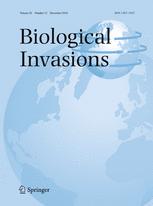Ver ítem
- xmlui.general.dspace_homeCentros Regionales y EEAsCentro Regional Patagonia NorteEEA BarilocheArtículos científicosxmlui.ArtifactBrowser.ItemViewer.trail
- Inicio
- Centros Regionales y EEAs
- Centro Regional Patagonia Norte
- EEA Bariloche
- Artículos científicos
- Ver ítem
Factors driving historic intercontinental invasions of European pine bark beetles
Resumen
Largely assisted by global trade, alien insect species are being introduced into new territories at unprecedented rates. Among forest insects, pine bark beetles (Coleoptera: Curculionidae, Scolytinae) are a large and diverse group commonly recognized as successful invaders and important tree mortality agents in pine forests and commercial plantations. In this study, we collected information
on the native and invaded distribution of 51 European bark
[ver mas...]
Largely assisted by global trade, alien insect species are being introduced into new territories at unprecedented rates. Among forest insects, pine bark beetles (Coleoptera: Curculionidae, Scolytinae) are a large and diverse group commonly recognized as successful invaders and important tree mortality agents in pine forests and commercial plantations. In this study, we collected information
on the native and invaded distribution of 51 European bark beetles developing in Pinus species. We analyzed their invasion history in the Southern Hemisphere and the Americas and explored several factors that can help explain their invasion success: (1) propagule pressure: interception frequency in the non-native range(2) invasibility: potential establishment area based on climatic matching and host availability and (3) invasiveness: biological traits of the bark beetles (i.e., feeding habit, host range, body size, mating system, colonization behavior). We found that most (87%) of the introductions of the species to new regions occurred in the period 1960–2013, and that variables related with the three main factors were relevant in explaining invasion success. Propagule
pressure was the factor that best explained bark beetle invasion probability, followed by invasibility of the novel area. In turn, biological attributes like mating system, body size and host range were also relevant, but showed a lower relative importance. Our study contributes to understand the main factors that explain forest insect invasion success. This information is critical for predicting future invasions to new regions and optimizing early-detection and biosecurity policies.
[Cerrar]

Autor
Fuente
Biological Invasions 24 : 2973-2991 (Junio 2022)
Fecha
2022-06
Editorial
Springer
ISSN
1387-3547
1573-1464
1573-1464
Formato
pdf
Tipo de documento
artículo
Palabras Claves
Derechos de acceso
Embargado
 Excepto donde se diga explicitamente, este item se publica bajo la siguiente descripción: Creative Commons Attribution-NonCommercial-ShareAlike 2.5 Unported (CC BY-NC-SA 2.5)
Excepto donde se diga explicitamente, este item se publica bajo la siguiente descripción: Creative Commons Attribution-NonCommercial-ShareAlike 2.5 Unported (CC BY-NC-SA 2.5)

